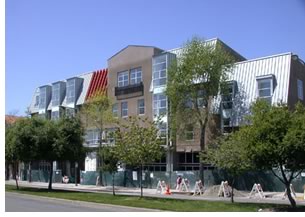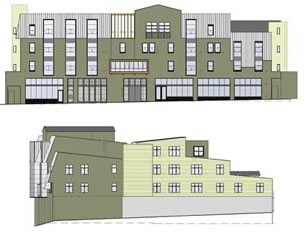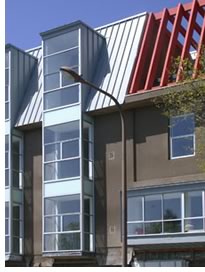

08/2005
Berkeley project offers integrated living for disabled
 A partnership between San Francisco-based Hearth Homes and Affordable
Housing Associates (AHA) in Berkeley, Calif., has produced the nation’s
first affordable- and universal-designed housing project. Located in
Berkeley on the site of a former paint store, University Neighborhood
Apartments features 29 residential units, common areas, and ground-floor
commercial space. All of the apartments are for low-income families,
and 14 units are reserved for disabled individuals and their families.
Residents for the disabled units are selected by lottery from individuals
on the Section 8 rental voucher waiting list in the City of Berkeley;
the remaining apartments are marketed to the general public.
A partnership between San Francisco-based Hearth Homes and Affordable
Housing Associates (AHA) in Berkeley, Calif., has produced the nation’s
first affordable- and universal-designed housing project. Located in
Berkeley on the site of a former paint store, University Neighborhood
Apartments features 29 residential units, common areas, and ground-floor
commercial space. All of the apartments are for low-income families,
and 14 units are reserved for disabled individuals and their families.
Residents for the disabled units are selected by lottery from individuals
on the Section 8 rental voucher waiting list in the City of Berkeley;
the remaining apartments are marketed to the general public.
Susan Friedland, executive director of AHA, credits Hearth Homes founder and president Sue Siegel’s “personal passion and vision for integrating disabled and non-disabled residents” for making University Neighborhood a reality. Born from Siegel’s experience caring for her husband after he was diagnosed with multiple sclerosis, Hearth Homes was founded with the purpose of “building integrated housing with a community spirit.” Siegel believes that housing disabled and non-disabled persons together helps both groups by ending isolation; educating able-bodied persons about disability and its challenges; and creating an inclusive, supportive, and caring community.
 Inclusive and integrated
Inclusive and integrated
Begun more than six years ago, the infill project occupies half an acre
within easy walking and wheelchair distance to a variety of mass transit
options. Because it is affordable housing, the funding required from
local, state, and private resources helped drive the inclusive, community-driven
design process. In addition, the immediate community was very vocal
about what they wanted to replace the former one-story paint store.
In their neighborhood of one- and two-story single family homes, the
community’s residents wanted a building that would integrate
nicely and pay attention to its architecture and heritage. “University
Neighborhood Apartments show that affordable housing does not have
to be ordinary,” says architect Kava Massih, AIA, principal of
Kava Massih Architects.
The urban complex provides 11 three-bedroom units, 14 two-bedroom units, 3 one-bedroom units, and one studio apartment. Universal features include one-story living; wide doorways and hallways; low countertops, cabinets, and keyholes; extra floor space to accommodate a wide turning radius; pull-out cutting boards; stoves with buttons on the front; push/pull lever faucets; and roll-in showers.
 Providing permanence and independence
Providing permanence and independence
At the opening July 13, Friedland recalls that residents spoke very movingly
about the stress and pressure of finding decent, affordable, universal-design
housing. “They talked about how they had felt marginalized by
society. In addition to being disabled, they have low incomes, which
severely limited their options. One significant benefit that University
Neighborhood Apartments provides is permanence: Now they don’t
have to worry about rising rents or being evicted. They can stay there
as long as they live. This has given them much greater freedom and
independence.”
Some tenants recalled how they felt trapped in their former residences because their mobility was so hindered by the surroundings that they couldn’t even visit neighbors, reports Friedland. Another resident spoke about how she “hadn’t felt water from a shower hit her skin in over 20 years.” In previous residences, she had no option but to use a cup and pail to bathe herself, but with the roll-in showers at University Neighborhood, she feels that her “sense of dignity and independence has been renewed.”
 “Unique and beautiful”
“Unique and beautiful”
Situated around an interior courtyard, the apartment complex has the “feel
of a small village,” with its variety of scale and massing. Resident
amenities include a large community room with an accessible kitchen,
computers, and a rooftop garden. In addition, residents will have access
to on-site computer training programs, cooperative child care, exercise
classes, movies, and common meals. San Francisco-based Toolworks will
administer case management, life skills instruction, employment assistance,
and personal support for disabled residents. Hearth Homes will offer
programs to integrate the residents with each other and their community.
As a testament to the success of the complex, Friedland says that there were more than three applicants for every unit and that every single family that saw the apartments signed a lease on the spot. “The apartments are so welcoming, spacious, and light-filled. It’s really a tribute to Kava Massih’s creativity and vision. Each apartment is unique and beautiful.”
Copyright 2005 The American Institute of Architects.
All rights reserved. Home Page ![]()
![]()
 |
||
7 Principles of Universal Design (Adapted from a paper by the Center for Universal Design, North Carolina State University, 1997.) • Equitable Use. The design is useful and marketable to people
with various abilities.
|
||